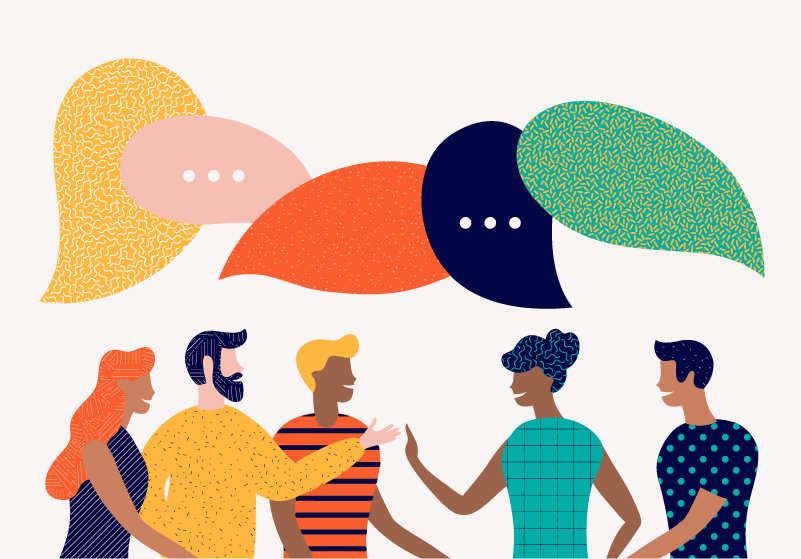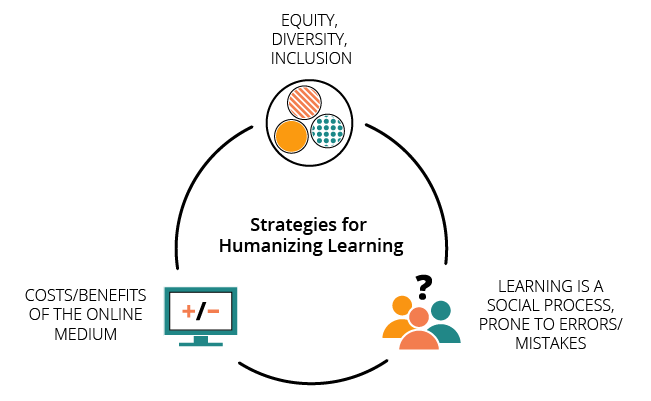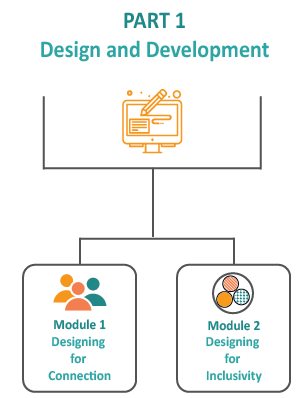About this course – Start here!
This course is designed to provide post-secondary educators (instructors and academic support unit [ASU] staff in the college and university sectors) with a foundation in high impact practices that foster real engagement, create authentic connection and community, support academic integrity, and provide valuable teaching and learning experiences online. Whether you’re creating a new online, remote, or blended course, revising an existing course, or facilitating your first-ever online, remote, or blended course, your own goals in taking this course will determine the outcomes you take away.
What you can take away from this course:
- Ideas, strategies, and resources (e.g., templates, rubrics, and lots of real examples) you can use in the creation (or revision) of your course that will help you foster engagement, connection, and interaction in your virtual courses and more rewarding teaching and learning experiences.
- The design and creation of inclusive and equitable learning experiences that feel authentic and engage both learners and instructors, drawing on frameworks such as User Experience Design for Learning (UXDL) and Universal Design for Learning (UDL), and principles of equity, diversity, decolonization and inclusivity (EDDI).
- Skill in identifying key affordances and challenges to teaching and learning in virtual environments and identify relevant strategies to help leverage the affordances and mitigate challenges in teaching virtually.
- The design of or ideas for new assessments that draw on humanizing strategies that support academic integrity (AI) and reduce the feasibility of and temptation to commit AI violations for your learners.
- creating opportunities in your virtual course for meaningful interactions, better engagement, deeper connections, and contribute to inclusive and equitable learning experiences.
- developing skills and confidence in communicating with your learners online (e.g., emails and discussion forums), including the ability to recognize and tactfully address challenging topics/content that may trigger some learners, as well as acts of aggression or micro-aggressions in online interactions.
- Identifying ways to garner learner feedback and taking a reflective, iterative improvement approach in your course design and facilitation, acknowledging that humanizing learning is a career-long journey.

Taking steps that help to break down barriers to learning, increase access, acknowledge diversity, and create opportunity for real connection and engagement is commonly referred to as humanizing virtual learning. Humanizing online learning is a broad and somewhat open-ended pursuit because almost every strategy one employs to create a quality online course can help to humanize your course, your learners, and you. From the design of assessments, to the presentation of content, to how instructors communicate with learners, every aspect of your online teaching can serve to humanize the experience.
Always at the heart of the work of humanizing learning, however, is an intention to improve teaching and learning online by:
- taking into consideration principles of equity and acknowledging the diversity in the backgrounds, abilities, and limitations of both the human who is creating the online instructional materials and teaching online, as well as the individual humans who are learning together and co-creating the learning community;
- understanding that human learning is inherently a social process, whereby knowledge and skills are shared in a way that enables growth and transformation (sometimes in both teacher and learner) and makes space for this human process of learning, where mistakes are inevitable and reflection, revision, and iteration are paramount for both the instructor and the learners; and
- aiming to leverage the affordances of the medium of virtual learning to create fulfilling teaching and learning experiences, while mitigating (and/or working wisely within) the limitations of the medium.

Image Description (PDF) | University of Waterloo
While this description is big picture and may sound a bit lofty, it is meant to provide some guiding principles and some goals to work towards. Humanizing learning is not an all-or-nothing pursuit, and any steps you feel comfortable taking
- to support equity, diversity, and inclusivity
- that acknowledges the social and trial-and-error nature of human learning and development, and
- that aims to leverage the affordances of the online medium and reduce barriers to learning
will enhance the experience of teaching and learning online for both you and your learners. If these are goals you aspire to, then this course is for you!
A note about the intended audience
This course is designed for educators in postsecondary education (PSE), and tips and examples will be grounded in this context. However, many principles and examples will translate readily to a K-12 or professional development context.
Customizing your approach to this course
Before creating this course we did our research and interviewed instructors and ASU staff from post-secondary institutions across Ontario to learn what they were looking for to help them develop strategies and skills in humanizing learning. The design and content in this course reflects the results of that analysis.
What we heard loud and clear is that instructors want tangible and applicable strategies presented in short and readily-digestible sections, covering a broad range of topics that are easy to find based on one’s interests, questions, goals, and time. One of the most consistent requests was to see these principles in action with examples and case studies across various disciplines, class sizes, and class formats (seminar, lecture-based, lab-based, etc.). We have created this course with these needs in mind.
This course takes a learner-centred approach, and we encourage you to be self-directed and self-determined in your learning path, navigating to the topics you are most interested in and creating your own customized materials and resources as you work through the material. We designed this course to serve ASU staff and instructors with a range of experiences in virtual learning, whether you are completely new to teaching virtually and are feeling overwhelmed by the daunting task of creating a brand new course or are experienced and looking to tweak and revise your online or blended course in a few targeted ways, or are teaching a course you haven’t designed and are looking for ways to set yourself and your learners up for success.
We have divided this course into two parts, each with two modules. The first module of each part focuses on strategies that foster authentic interaction and connection, while the second module focuses on how to apply principles of equity and inclusivity:
Part 1 – Design and Development is dedicated to design and development of resources. This is where you’ll want to start if you are designing or re-designing a virtual course or resources (online or blended).
There are two modules in Part 1:

Part 2 – Delivery and Facilitation is dedicated to the delivery of virtual courses or course components. This may be where you’d like to start if your course is already designed and developed and you want to jump right into teaching strategies you can use to foster interactions, communication, connection, and community.
There are two modules in Part 2:

Every module contains the following sections:
Humanizing learning is a career-long journey

Each module focuses on high-impact strategies and examples, but few online courses employ all these strategies well. Be kind to yourself and recognize that humanizing learning and teaching in more inclusive and equitable ways is a career-long journey. So if you are new to virtual teaching and learning (or even if you are a veteran), we encourage you to start by selecting a couple of areas to focus on, or to choose one simple strategy in each area that you can integrate into your course(s) that feels manageable. Aim to continue to iterate, build, and grow your approach to virtual course design and facilitation over time.
Where to start?
Navigating this course
There are three ways to navigate through the content of this course:
- Click the Contents bar in the navigation panel to navigate between sections.
- Use the Module overview page for quick links to the sections within a module.
- Use the Previous/Next links in the footer at the very bottom of the screen to go back and forth through the content
Accessibility statement
We developed this course with a commitment to accessibility and usability for all learners.
The accessibility of this course was assessed by the Centre for Extended Learning, University of Waterloo. This review was based on the WCAG 2.0 Guidelines at success criteria Level AA. The course authors have addressed all known accessibility issues to the best of their abilities.
The following known accessibility issue persists and may cause difficulties for some persons with disabilities:
- Previous and Next page buttons are difficult to find and the use of orange text over a dark purple background is not optimal.
This issue was not resolved because it is a limitation of Pressbooks.
About the authors and development team
We are a team of instructional designers and educational developers who have brought our combined years’ experience in online learning to the design and development of this course. Although we come from a variety of personal and professional backgrounds, we recognize that we do not (and cannot) encompass every experience. As a result, we have sought to incorporate equity, diversity, decolonization and inclusion (EDDI) principles into all the concepts and approaches we highlight throughout the course in order to acknowledge the diversity of our learners, instructors, and educational support staff in the online learning environment.
We also humbly acknowledge that we have co-created this learning material across the traditional lands of many Indigenous Peoples, including the Anishinaabe, Haudenosaunee, Huron-Wendat, Seneca, Mississaugas of the Credit, Neutral, and Ojibway/Chippewa peoples. Many Métis, Inuit, and First Nations from across Turtle Island also call these lands home today. We express gratitude to those that reside here, for their teachings about the land and our relations, and hope to honour those teachings through this course and through the work we do together during and after this course.
The course development team:
- Marcia Chaudet | LinkedIn | (Coauthor), Conestoga College
- Lake Dyer | LinkedIn | (Quality Assurance), University of Waterloo
- Stephanie Ferguson | LinkedIn | (Coauthor), Trent University
- Mitchell Huguenin | LinkedIn | (EDDI and Indigenization Specialist), Trent University
- Antonina Joukova | LinkedIn | (Multimedia Developer), University of Waterloo
- Tahira Mursleen | LinkedIn | (Multimedia Developer), University of Waterloo
- Meg Neitsch | LinkedIn | (Project Management), University of Waterloo
- Blair Niblett | LinkedIn | (EDDI Specialist and Co-author), Trent University
- Daniel Opperwall | LinkedIn | (Coauthor), University of Waterloo
- Robert Parker | LinkedIn | (Coauthor), Conestoga College
- Jenny Stodola | LinkedIn | (EDDI Specialist and Coauthor), Online Learning Consultant
- Kristin Wilson | LinkedIn | (Project Lead and Coauthor), University of Waterloo
- Pia Zeni | LinkedIn | (Instructional Design), University of Waterloo
Funding
This project is made possible with funding by the Government of Ontario and through eCampusOntario’s support of the Virtual Learning Strategy. To learn more about the Virtual Learning Strategy visit: https://vls.ecampusontario.ca/.

Copying, modifying, and reusing this resource
This resource is licensed under a creative commons license that allows for copying, reuse, and modification of this resource (CC-BY-NC-SA 4.0 International), as long as the reuse is:
- attributed to this original work (BY),
- is non-commercial (N-C), and
- is shared alike (SA) retaining this same CC license.
This holds for all materials in the course, except where otherwise stated. There are some exceptions to this license, where the authors of this resource are not the copyright holders – some visuals/images and some instructor examples. These exemptions cannot be copied without permission from the copyright holder. These are clearly labelled throughout the course with the copyright symbol © and a short copyright citation appearing under the visual or example and a full reference listed on the copyright holder on the Copyright & Media Attributions page. This page contains a complete list of all these exceptions in the course.

